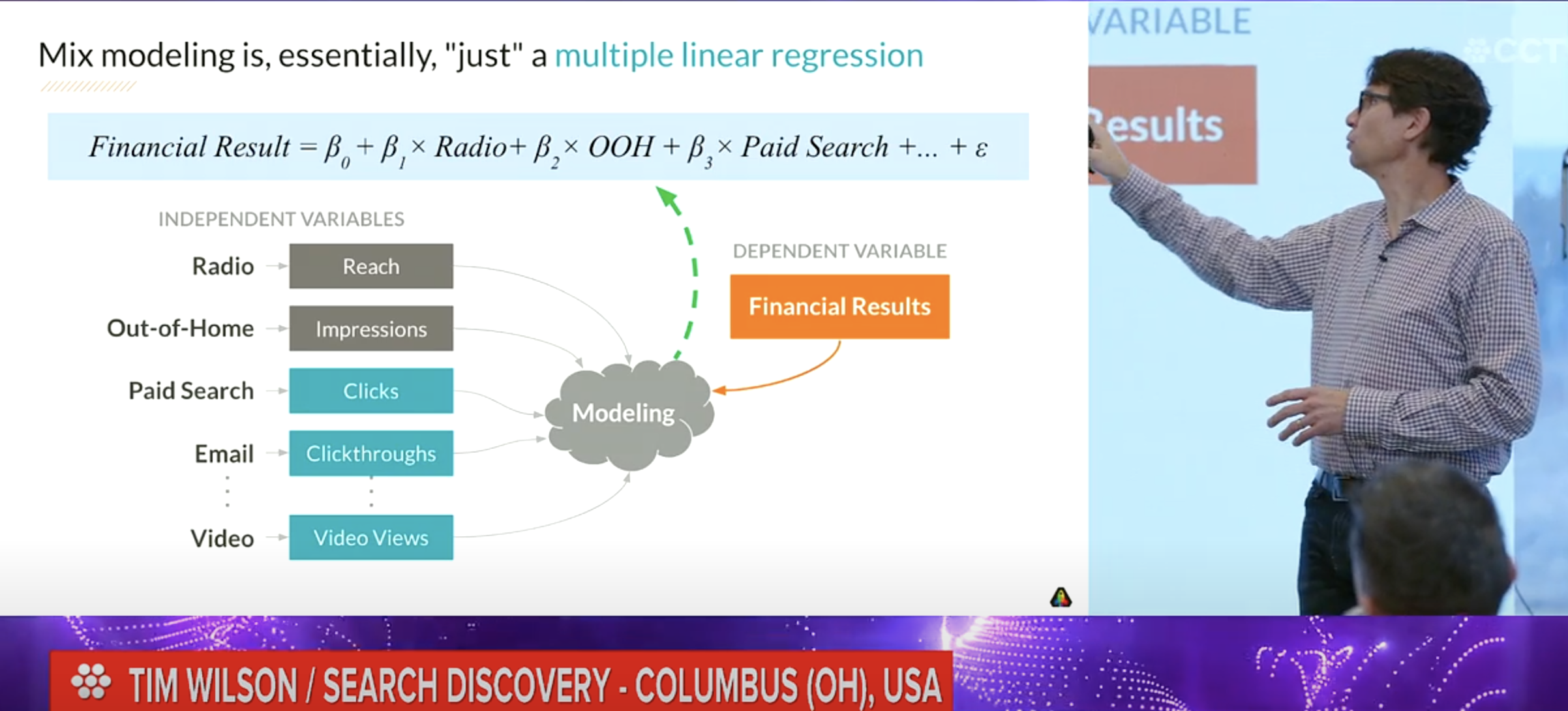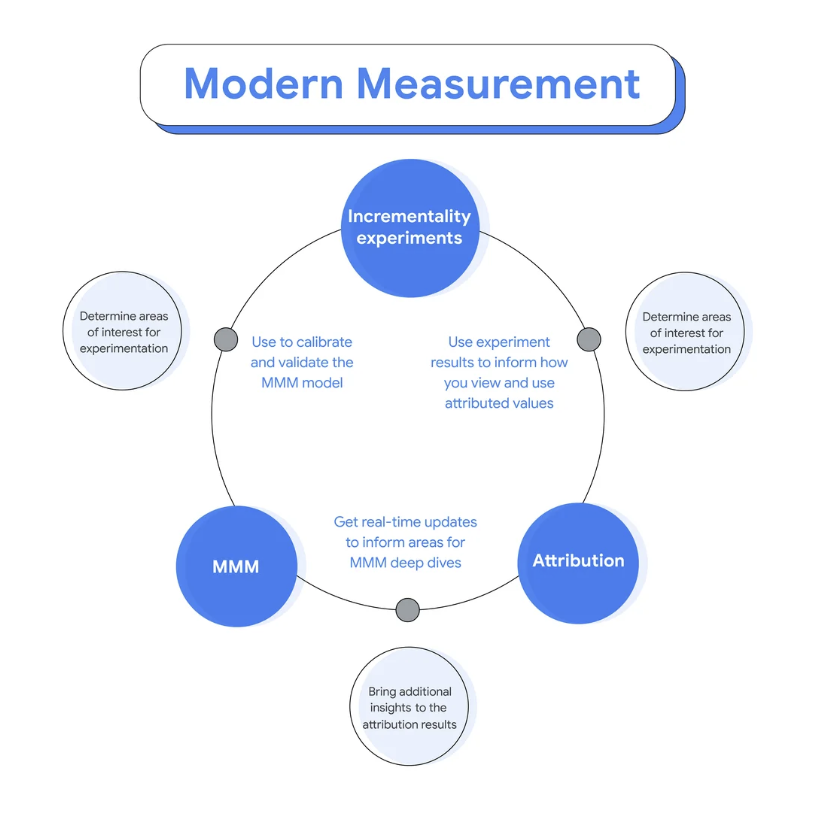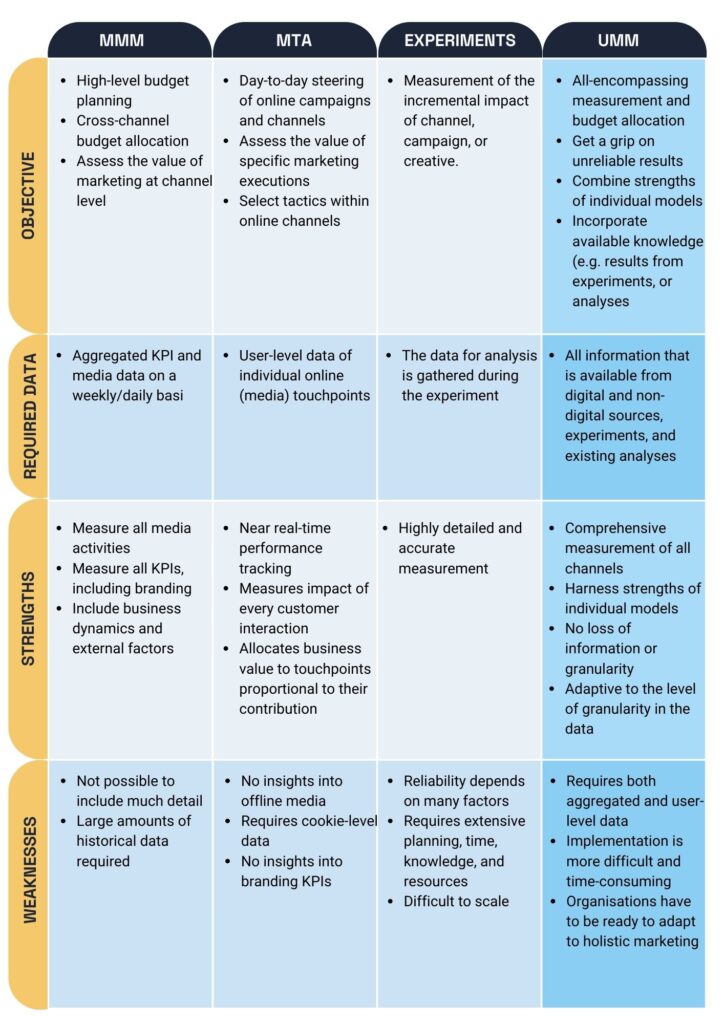This article examines the three key methods of marketing measurement—Marketing Mix Modeling (MMM), Multi-Touch Attribution (MTA), and Conversion Lift Studies (CLS). It explores their strengths, challenges, and the emerging trend of combining these approaches, called triangulation or Unified Marketing Measurement (UMM).
Marketing measurement is the process of quantifying the effectiveness of a marketing campaign or strategy.
In today’s complex marketing landscape, measuring the effectiveness of advertising spend has become both more crucial and more challenging than ever.
As marketing channels multiply and privacy concerns reshape the digital environment, organizations are facing with a fundamental question:
How do we accurately measure the impact of our marketing efforts?
Additionally, they need to understand the potential return on investment.
How many additional sales would result from an extra £1,000 spent on marketing?
The Three Pillars of Marketing Measurement #
Marketing teams currently rely on these three primary methods to evaluate the true impact of their efforts:
- Marketing Mix Modeling (MMM)
- Multi-Touch Attribution (MTA)
- Testing/Conversion Lift Studies (CLS)
Let’s break down what these methods are, how they differ, and when to use each one.
Marketing Mix Modeling (MMM) #
Before we had the internet, how did marketers measure ads? You can’t click on a TV ad or tap on a newspaper to get to a website.
This fundamental challenge led to the development of Marketing Mix Modeling (MMM), previously known as econometric modeling.
Think of it as viewing your marketing efforts from a helicopter – It looks at the big picture – providing a holistic view on how all your marketing channels work together to drive sales. It considers factors such as:
- Total advertising spend across channels
- Overall social media budgets
- Seasonal trends
- Economic factors
- Competitor activity
- Even the weather

Strengths & Limitations #
Originally developed in the 1960s to measure traditional advertising effectiveness, MMM has experienced a renaissance in recent years. This resurgence is largely due to its privacy-compliant nature, as it relies on aggregate data rather than individual user tracking like impressions or clicks.
Modern tools like Meta’s open-source Robyn library have made MMM more accessible, while vendors like Recast have worked to modernize the technique.
However, it’s not without challenges. It requires substantial historical data (typically two to three years), takes time to implement, and often needs expert-level analytical skills.
MMM also doesn’t work at a campaign level, meaning it can’t provide the detailed insights that marketers need for adjusting budgets and optimizing their daily activities.
Another issue is that MMM doesn’t track individual customer actions. For example, if a person clicks on a Google Search ad and later clicks on a retargeting ad, MMM can’t tell you how many times this happens. It only looks at overall trends, not specific user behaviors.
For Example:
Imagine you spend £1M on marketing across TV, social media, and search ads.
MMM might tell you:
- TV ads drive 40% of total sales.
- Social media contributes 30%.
- Search ads account for 30%.
However, it won’t tell you:
- Which specific ad led to an individual purchase.
- How many times a single customer clicked before converting.
Multi-Touch Attribution (MTA) #
If MMM provides a helicopter view, MTA is like following a customer’s footprints through their buying journey.
MTA uses digital tracking through UTM codes and tracking pixels to tracks the specific steps someone takes before buying (user interactions across various touchpoints), such as:
- Google ad clicks
- Website visits
- Email engagements
- Purchase completions
MTA has been the default measurement approach for digital marketing, with Google Analytics leading the way as the primary tool installed on 60% of the top 100,000 websites. In fact, we can safely assume that virtually every online retailer uses some form of MTA, as Google Analytics has become a standard tool in the digital marketing stack.
Strengths & Limitations #
This approach assigns credit to different channels a user interacted with, based on predefined rules or statistical models. Allowing to answer detailed questions, like: “How should I distribute the budget across my campaigns and ad groups?” or “Which copy or creative asset works best?”.
However, the increasing focus on privacy protection and the phasing out of third-party cookies has begun to challenge MTA’s effectiveness.
For more details about the Multi-Touch Attribution, you can refer to this blog post.MMM vs MTA: Summary of Differences #
- The primary difference between the two is the objective of each approach:
- MTA focuses on the specific individual touch points and how they impact sales and conversion.
- MMM focuses on your overall marketing mix and how that influences sales and other outcomes.
- The secondary difference is the type of data each approach uses:
- MTA utilizes very granular data at the device level.
- MMM uses aggregated data at the channel level.
|
Aspect |
Marketing Mix Modeling (MMM) |
Multi-Touch Attribution (MTA) |
|---|---|---|
| Data Source | Aggregated data (e.g., weekly sales) | User-level data (e.g., clickstream) |
| Scope | Offline and online channels | Primarily online channels |
| Granularity | Channel-level insights | Campaign and touchpoint-level insights |
| Speed | Slow; requires historical data | Near real-time (if tracking is enabled) |
| Privacy Compliance | Fully GDPR-compliant | Challenged by privacy regulations |
| Applications | Branding, offline marketing | Performance marketing, digital campaigns |
| Causality | Incorporates external factors | Focuses on trackable interactions |
MMM vs MTA: The Football Analogy #
To understand the difference between Marketing Mix Modeling (MMM) and Multi-Touch Attribution (MTA) using the football analogy, let’s expand on how each approach would evaluate a player’s performance:
Multi-Touch Attribution (MTA): This method is like analyzing every single play made by a player during a match to determine their impact on the game’s outcome. In digital marketing, MTA assesses every interaction a customer has with a brand across different channels before making a purchase. It looks at each touchpoint—be it an ad click, an email open, or a social media interaction—to determine which ones contributed most to the final decision and assigns value accordingly. This approach is highly granular and operates almost in real-time, focusing on direct interactions leading up to a conversion.
Marketing Mix Modeling (MMM): In contrast, MMM is like evaluating a player’s performance over a whole season to determine their overall impact on the team’s success. MMM considers a broader range of factors, including both marketing tactics and external influences such as market trends, economic conditions, and competitor actions. In marketing, MMM analyzes historical data to understand how various elements of the marketing mix (like media spending, promotions, and competitive activity) contribute to sales and conversions over a longer period. This method provides strategic insights, helping businesses allocate their budgets more effectively for future campaigns by understanding long-term trends and elasticities.
Incorporating MMM in the Example: If we apply the MMM approach to our football analogy, we would not only look at each player’s direct actions in games but also consider external factors such as weather conditions, the quality of the opposition, and even the player’s fitness and morale over the season. Similarly, MMM in marketing evaluates how broader factors and different marketing channels collectively impact sales and brand performance, providing a macro-level view that helps in strategic decision-making.
Conversion Lift Studies (CLS) #
CLS serves as a validation tool, allowing marketers to measure the actual impact of their campaigns through controlled experiments. These studies typically involve:
- Dividing audiences into random groups
- Varying marketing exposure between groups
- Measuring the resulting differences in conversion rates
- Using statistical analysis to determine causality
Strengths & Limitations #
Through these tests, it is possible to empirically and accurately validate the effectiveness of marketing actions.
However, A/B testing requires a large sample and sufficient time to ensure accuracy.
For more details about the A/B testing, you can refer to this blog post.
The Rise of Triangulation: The Unified Marketing Measurement (UMM) #
As MMM, a decades-old methodology, experiences a renaissance and MTA, the traditional dominance, faces transformation, many organizations are adopting a hybrid approach that combines the strengths of the three methodologies. This approach, often called unified marketing measurement (UMM) or triangulation, integrates MMM, MTA, and incremental testing for a comprehensive view of marketing performance.

Basically, instead of examining the results from MMM, MTA, or in-platform attribution in isolation, the idea is to blend all this information to get a single, coherent metric for each channel, in order to provide a unified marketing measurement (UMM). The outcome allows marketers to determine the ROI of their efforts, allocate future spend, and create sales forecasts.
Unified marketing measurement is not a model, but rather a methodology or approach that maximizes the use of available data sources and techniques to create a single truth suitable for actionable steering.
How Triangulation Works:
Marketers often blend insights from the different models in an attempt to create consistency, but this is like comparing apples and oranges, and sacrifices accuracy.
Instead of combining insights from different models, measurement accuracy can be gained by blending the data and methodology at a technical level.
[…] we can transfer knowledge from one model to another. As a result, marketers get a grip on unreliable modeling results and they have consistent, more accurate insights available that are comparable across different departments.
- Strategic Planning: Use MMM to allocate budgets and develop long-term strategies.
- Tactical Execution: Leverage MTA for day-to-day campaign adjustments.
- Validation: Apply incremental testing to verify marketing impact.
For instance, a large retailer might use MMM to allocate budgets across TV, digital, and social media, while employing MTA to fine-tune Google Ads campaigns in real time.
This dual approach provides both strategic insight and tactical agility.
A case study by Lenny’s Newsletter, which analyzed 42 top consumer brands including Uber, Amazon, and Airbnb, revealed that over 40% of these brands utilize at least two measurement methods simultaneously. Additionally, approximately 20% of the brands employ all three methods to assess their marketing performance.
Strengths & Limitations #

Implementation Challenges and Solutions #
Organizations adopting these measurement approaches face several common challenges:
Data Silos: Traditional methodologies such as MMM, MTA, and experiments often exist within organizational silos. Breaking down these silos requires not just technical solutions but also organizational alignment.
Skill Gaps: Both methodologies demand expertise in data science and marketing analytics. Companies are addressing this through a combination of hiring, training, and partnerships with specialized analytics providers.
Conflicting Insights: Lack of consistency across silos lead to each department operating based on different insights. When MMM and MTA produce different recommendations, clear communication protocols and robust methodologies help align decision-making.
Looking Ahead: The Future of Marketing Measurement #
As we look to the future, several trends are shaping the evolution of marketing measurement:
Privacy-Preserving Analytics: New technologies are emerging that enable detailed measurement while maintaining user privacy.
AI Integration: Advanced artificial intelligence is making sophisticated modeling more accessible to organizations of all sizes.
Real-Time Capabilities: Unified platforms are enabling faster and more reliable decision-making.
Democratization: Sophisticated measurement tools are becoming available to smaller organizations.
For more details about the democratization of data and the future of analytics in an automated world, you can refer to this blog post.
Conclusion #
The future of marketing measurement lies not in choosing between methodologies but in understanding how to leverage each one’s strengths. As privacy concerns continue to reshape the digital landscape, organizations that successfully implement a balanced, hybrid approach to measurement will gain a significant competitive advantage.
The key to success in this new era of marketing measurement is adaptability. Companies must be willing to evolve their measurement strategies, embracing new technologies and methodologies while maintaining a steadfast commitment to consumer privacy. Those who master this balance will be best positioned to optimize their marketing investments and drive sustainable growth in the years ahead.
Reference and Useful Links #
- Google’s “The modern measurement” playbook: Link
- Google – The Unified Marketing Measurement (UMM) [PDF]: Link
- Google – The MMM Handbook: Link
- Lenny’s Newsletter – How today’s top consumer brands measure marketing’s impact: Link
- Measurelab – The Measure Pod: #113: Link
- GA4 Attribution Models Explained: Link
